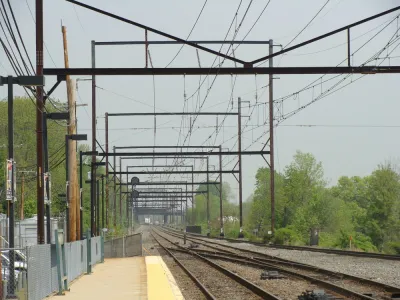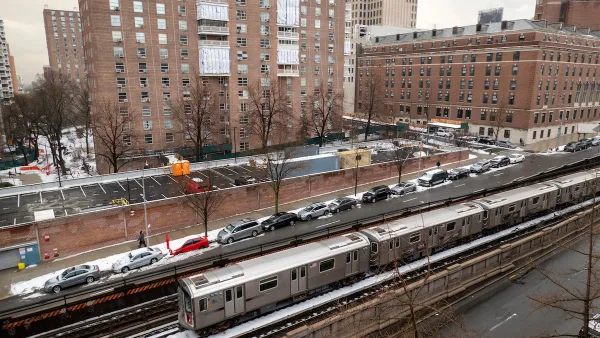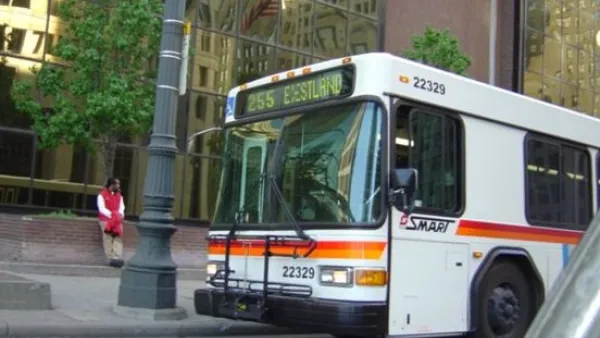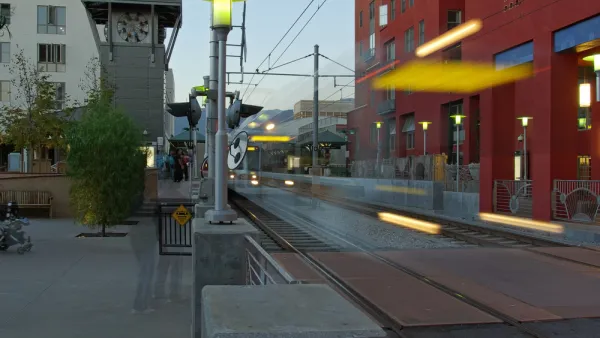With ridership revenue down, agencies seek to diversify their revenue stream by taking a more active role in developing agency-owned land.

With transit ridership down 79% in 2020 and a nationwide budget shortfall of close to $40 billion, writes Nate Berg for Fast Company, struggling public transit agencies are looking to revive their revenue through other means. Because many of them own land near their transit lines, some agencies are looking to the development of transit-agency-owned land as a potentially significant revenue source.
Until recently, most transit agencies used their land for surface parking, hoping ample parking near transit stations would draw more riders. But Jessie O'Malley Solis, transit-oriented development manager for the Santa Clara Valley Transportation Authority, says that in their area, it didn't work that way. "Just building seas of parking wasn’t going to generate ridership. You needed to generate connectivity along the system to make it valuable for riders." Now, as residents in Silicon Valley struggle to find housing in one of the country's least affordable markets, VTA is making plans to turn some of its land into "new transit-adjacent community hubs" and hopes its own development will have a ripple effect that encourages more private development near station areas. "O’Malley Solis says the development is always geared toward improving ridership and making more transit-oriented communities—whether it’s on land the agency owns or not."
While transit-oriented development isn't a silver bullet for increased ridership, "when done well, these projects can make an impact" on commuter mode share as well as increase the availability of affordable housing and the sustainability of transit agency budgets.
FULL STORY: Facing a $40 billion shortfall, U.S. transit agencies jump into real estate

National Parks Layoffs Will Cause Communities to Lose Billions
Thousands of essential park workers were laid off this week, just before the busy spring break season.

Retro-silient?: America’s First “Eco-burb,” The Woodlands Turns 50
A master-planned community north of Houston offers lessons on green infrastructure and resilient design, but falls short of its founder’s lofty affordability and walkability goals.

Delivering for America Plan Will Downgrade Mail Service in at Least 49.5 Percent of Zip Codes
Republican and Democrat lawmakers criticize the plan for its disproportionate negative impact on rural communities.

Test News Post 1
This is a summary

Test News Headline 46
Test for the image on the front page.

Balancing Bombs and Butterflies: How the National Guard Protects a Rare Species
The National Guard at Fort Indiantown Gap uses GIS technology and land management strategies to balance military training with conservation efforts, ensuring the survival of the rare eastern regal fritillary butterfly.
Urban Design for Planners 1: Software Tools
This six-course series explores essential urban design concepts using open source software and equips planners with the tools they need to participate fully in the urban design process.
Planning for Universal Design
Learn the tools for implementing Universal Design in planning regulations.
EMC Planning Group, Inc.
Planetizen
Planetizen
Mpact (formerly Rail~Volution)
Great Falls Development Authority, Inc.
HUDs Office of Policy Development and Research
NYU Wagner Graduate School of Public Service





























